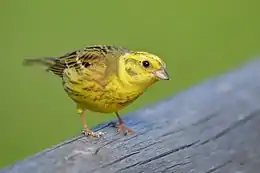Emberizidae | ||
|---|---|---|
 | ||
| Clasificación científica | ||
| Reinu: | Animalia | |
| Filu: | Chordata | |
| Clas: | Aves | |
| Orde: | Passeriformes | |
| Familia: |
Emberizidae Vigors, 1831 | |
| Xéneros | ||
ver testu | ||
| Consultes | ||
| [editar datos en Wikidata] | ||
Los emberízidos (Emberizidae) ye un clado d'aves paseriformes que se distribúi a lo llargo d'América y en menor midida n'Asia, África y Europa.
Sistemática
Ta nun procesu de fonda revisión.[1][2][3][4] Numberosos xéneros antes asitiaos nesta familia fueron tresferíos a la familia Thraupidae acordies cola Propuesta Nᵘ512 al South American Classification Committee (SACC).[5]
Llista de xéneros
D'alcuerdu a les clasificaciones del Congresu Ornitolóxicu Internacional (IOC) (Versión 4.3, 2014)[6] y Clements Checklist 6.9[7] la presente familia arrexuntaba a los siguientes xéneros, con delles diferencies que van ser comentaes en nota:
- Aimophila
- Ammodramus
- Amphispiza
- Arremon
- Arremonops
- Artemisiospiza
- Atlapetes
- Calamospiza
- Chlorospingus
- Chondestes
- Emberiza
- Gubernatrix
- Xuncu
- Latoucheornis
- Melophus
- Melospiza
- Melozone
- Miliaria
- Oreothraupis
- Oriturus
- Passerculus
- Passerella
- Peucaea
- Pezopetes
- Pipilo
- Pooecetes
- Porphyrospiza
- Pselliophorus
- Rhynchospiza
- Spizella
- Torreornis
- Xenospiza
- Zonotrichia
Notes taxonómiques
- Porphyrospiza foi tresferíu de Emberizidae para Thraupidae acordies cola Propuesta Nᵘ512 al SACC[5] con base en morfoloxía y datos xenéticos de Klicka et al, 2007.[8] Esti cambéu foi adoptáu por Clements pero calteníu en Emberizidae pol IOC.[6]
- Gubernatrix foi tresferíu de Emberizidae pa Thraupidae acordies cola Propuesta Nᵘ512 al SACC[5] con base en morfoloxía y datos xenéticos de Campagna et al, 2011.[9] Esti cambéu foi adoptáu por Clements pero calteníu en Emberizidae pol IOC.[6]
- Oreothraupis ye incluyíu en Thraupidae pol IOC[6] y en Emberizidae por Clements.[7]
- Los xéneros monotípicos asiáticos Melophus y Latoucheornis consideraos por Clements,[7] son incluyíos en Emberiza pol IOC.[6]
- El xéneru monotípicu del Paleárticu Miliaria ye incluyíu en Emberiza por dambes clasificaciones.[7][6]
- El xéneru Chlorospingus foi tresferíu de Thraupidae pa Emberizidae acordies cola Propuesta Nᵘ426 al SACC[10] con base en datos xenéticos de Burns et al. 2002, 2003 y Klicka et al. 2007,[8] DaCosta et al. 2009.[11]
- Siete especies antes nel xéneru Aimophila fueron incluyíes en Peucaea d'alcuerdu a (Da Costa et al 2009, NACC 2009-A-12a).[6]
- Dos especies antes nel xéneru Aimophila fueron incluyíes en Rhynchospiza acordies cola Propuesta Nᵘ456 al SACC[12] con base en datos xenéticos de Da Costa et al, 2009.[11]
- Toles especies del Nuevu Mundu fueron tresferíes a la nueva familia Passerellidae, según la Sociedá Ornitolóxica d'Estaos Xuníos,[13] depués adoptáu por Clements Checklist 2017.[14]
Xéneros tresferíos
Del presente pa Thraupidae acordies cola Propuesta Nᵘ512 al South American Classification Committee (SACC):[5]
- Porphyrospiza
- Phrygilus
- Melanodera
- Haplospiza
- Idiopsar
- Diuca
- Lophospingus
- Poospiza
- Compsospiza
- Sicalis
- Emberizoides
- Embernagra
- Volatinia
- Sporophila
- Oryzoborus
- Dolospingus
- Catamenia
- Coryphospingus
- Rhodospingus
- Gubernatrix
- Camarhynchus
- Certhidea
- Euneornis
- Geospiza
- Loxigilla
- Loxipasser
- Melanospiza
- Melopyrrha
- Pinaroloxias
- Platyspiza
- Tiaris
- Donacospiza
- Piezorhina o Piezorina
- Xenospingus
- Incaspiza
- Charitospiza
- Coryphaspiza
Referencies
- ↑ Burns, K. J., S. J. Hackett, and N. K. Klein, 2002. Phylogenetic relationships and morphological diversity in Darwin's finches and their relatives. Evolution 56 (6). 1240-1252.
- ↑ Lougheed, S.C., J.R. Freeland, P. Handford & P.T. Boag. 2000. A molecular phylogeny of warbling-finches (Poospiza): paraphyly in a Neotropical emberizid genus. Mol. Phylogenet. Evol. 17: 367-378.
- ↑ Burns, K. J., S. J. Hackett, and N. K. Klein. 2003. Phylogenetic relationships of Neotropical honeycreepers and the evolution of feeding morphology. J. Avian Biology 34: 360-370.
- ↑ Yuri, T., and D. P. Mindell. 2002. Molecular phylogenetic analysis of Fringillidae, "New World nine-primaried oscines" (Aves: Passeriformes). Mol. Phylogen. Evol. 23:229-243.
- 1 2 3 4 Propuesta (512) al South American Classification Committee: Tresferir xéneros de Emberizidae a Thraupidae n'inglés.
- 1 2 3 4 5 6 7 Gill, F & D Donsker (Eds). 2014. IOC World Bird List (v 4.3). doi:10.14344/IOC.ML.4.3. Disponible en IOC – World Birds names - Bananaquit, buntings, sparrows & bush tanagers. Consultada'l 23 d'ochobre de 2014.
- 1 2 3 4 Clements, J. F., T. S. Schulenberg, M. J. Iliff, B.L. Sullivan, C. L. Wood, and D. Roberson. 2014. The eBird/Clements checklist of birds of the world: Version 6.9. Downloaded from Downloadable checklist|Clements Checklist 6.9
- 1 2 KLICKA, J., K. BURNS, AND G. M. SPELLMAN. 2007. Defining a monophyletic Cardinalini: A molecular perspective. Molecular Phylogenetics and Evolution 45: 1014–1032. Estractu.
- ↑ CAMPAGNA, L., K. GEALE, P. HANDFORD, D. A. LIJTMAER, P. L. TUBARO, AND S. C. LOUGHEED. 2011. A molecular phylogeny of the Sierra-Finches (Phrygilus, Passeriformes): estreme polyphyly in a group of Andean specialists). Molecular Phylogenetics and Evolution 61: 521–533. Estractu.
- ↑ Propuesta (426) al South American Classification Committee: Asitiar Chlorospingus en Emberizidae n'inglés
- 1 2 DaCOSTA, J. M., G. M. SPELLMAN, P. ESCALANTE, AND J. KLICKA. 2009. A molecular systematic revision of two historically problematic songbird clades: Aimophila and Pipilo. J. Avian Biology 40: 206-216.
- ↑ Propuesta (456) al South American Classification Committe: Resucitar Rhynchospiza dende'l suramericanu Aimophila n'Inglés.
- ↑ Chesser, R.T., K.J. Burns, C. Cicero, J.L. Dunn, A.W. Kratter, I.J. Lovette, P.C. Rasmussen, J.V. Remsen, Jr., J.D. Rising, D.F. Stotz, and K. Winker. 2017. Fifty-eighth supplement to the American Ornithological Society’s Check-list of North American birds. Auk 134: 751-773.
- ↑ Clements, J. F., T. S. Schulenberg, M. J. Iliff, D. Roberson, T. A. Fredericks, B. L. Sullivan, and C. L. Wood. 2017. The eBird/Clements checklist of birds of the world: v2017. Downloaded from http://www.birds.cornell.edu/clementschecklist/download/
Enllaces esternos
| Wikispecies tien un artículu sobre Emberizidae. |
This article is issued from Wikipedia. The text is licensed under Creative Commons - Attribution - Sharealike. Additional terms may apply for the media files.